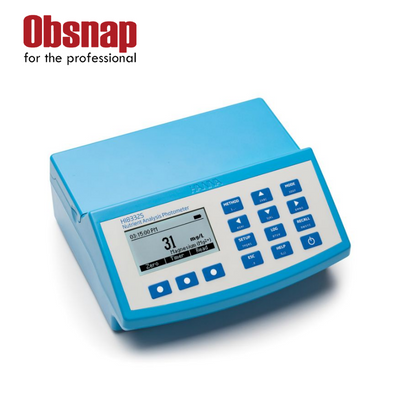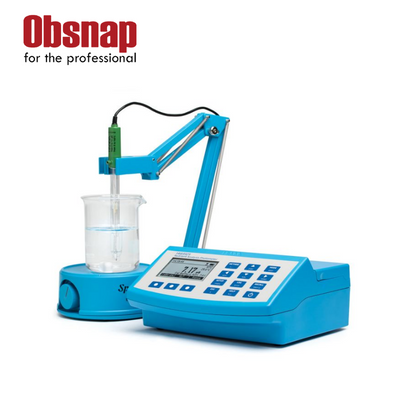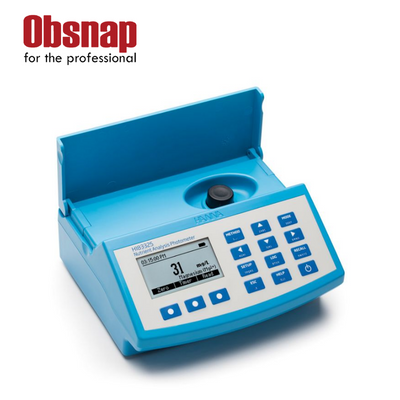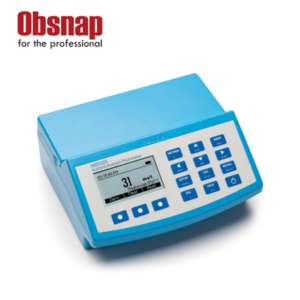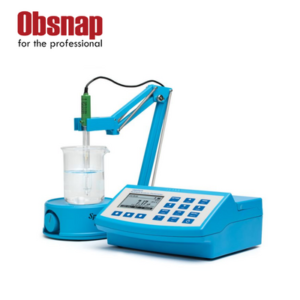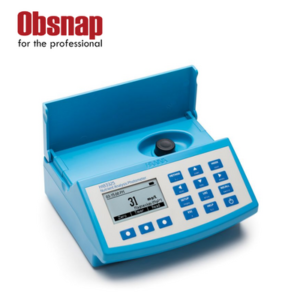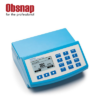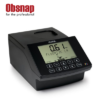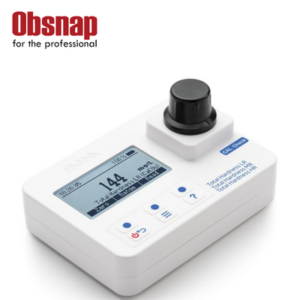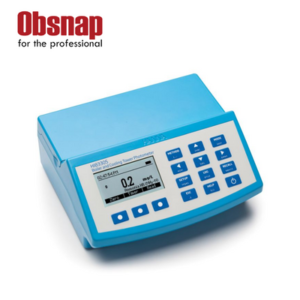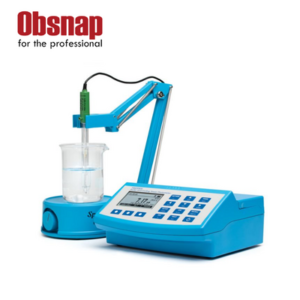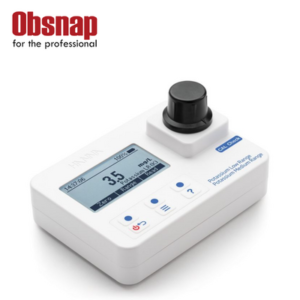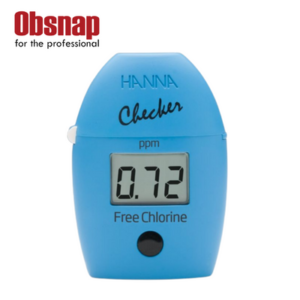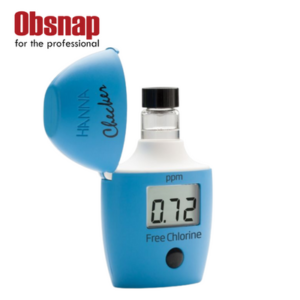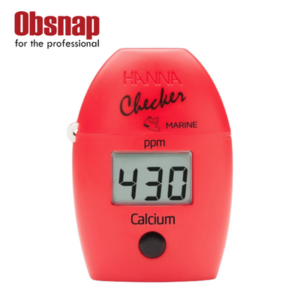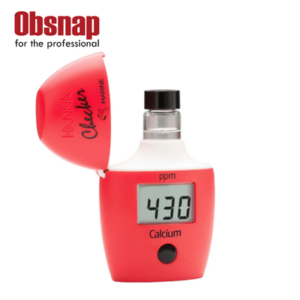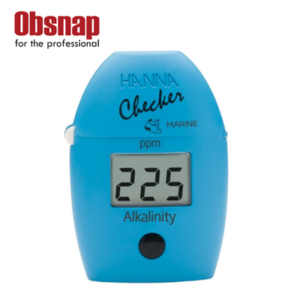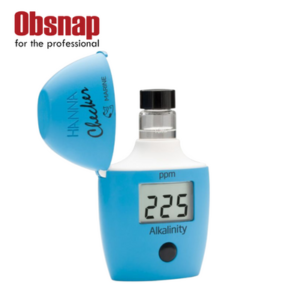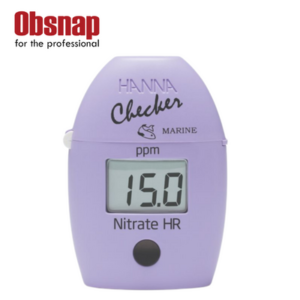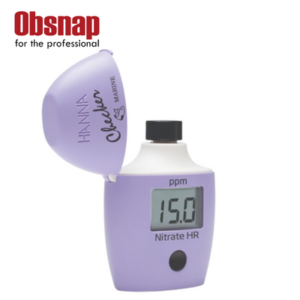Hanna Instrument Nutrient Analysis Photometer – HI83325
The HI83325 is a small multiparameter photometer that can be used in the lab or in the field. The metre is one of the most advanced on the market, with an innovative optical design that employs a reference detector and focusing lens to eliminate errors caused by changes in the light source and imperfections in the glass cuvette. This metre has nine different programmed methods for measuring eight key plant nutrient water quality parameters, as well as an absorbance measurement mode for performance verification and users who want to develop their own concentration versus absorbance curves. Potassium, calcium, and magnesium are planted nutrient-specific parameters.
With its digital pH/temperature electrode input, the HI83325 doubles as a professional pH meter, saving valuable laboratory benchtop space. Now, a single meter can perform both photometric and pH measurements.
- A cutting-edge optical system
- A benchtop photometer with unrivaled performance
- Input from a digital pH electrode
- Save valuable bench space by using a meter that functions as both a photometer and a laboratory pH meter.
- Mode of measuring absorbance
Features/Benefits:
Backlit 128 x 64 Pixel Graphic LCD Display
- A backlit graphic display allows for easy viewing in low light conditions
- The 128 x 64 Pixel LCD allows for a simplified user interface with virtual keys and on-screen help to guide the user through the use of the meter
Built-in Reaction Timer for Photometric Measurements
- The measurement is taken after the countdown timer expires.
- The countdown timer ensures that all readings are taken at the appropriate reaction intervals regardless of user for better consistency in measurements
Absorbance mode
- Hanna’s exclusive CAL Check cuvettes for validation of light source and detector
- Allows for the user to plot concentration versus absorbance for a specific wavelength for use with user supplied chemistry or for teaching principles of photometry
Units of Measure
- An appropriate unit of measure along with chemical form is displayed along with reading
Result Conversion
- Automatically convert readings to other chemical forms with the touch of a button
Cuvette Cover
- Aids in preventing stray light from affecting measurements
Digital pH Electrode Input
- Measure pH and temperature with a single probe
- Good Laboratory Practice (GLP) to track calibration information including date, time, buffers used, offset and slope for traceability
- pH CAL Check alerts user to potential problems during the calibration process
- Space saving having a pH meter and photometer built into one meter
Data Logging
- Up to 1000 photometric and pH readings can be stored by simply pressing the dedicated LOG button. Logged readings are just as easily recalled by pressing the RCL button
- Sample ID and User ID information can be added to a logged reading using the alphanumeric keypad
Connectivity
- Logged readings can be quickly and easily transferred to a flash drive using the USB-A host port or to a computer using the micro USB-B port
- Data is exported as a . CSV file for use with common spreadsheet programs
Battery Status Indicator
- Indicates the amount of battery life left
Error Messages
- Photometric error messages include no cap, high zero, and standard too low
- pH calibration messages include a clean electrode, check buffer and check probe
On-screen Features
 Method Selection
Method SelectionUsers can easily select any one of the 9 measurement methods via the dedicated METHOD button.
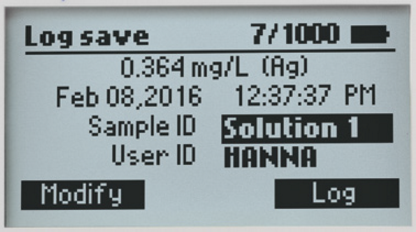 Data Logging
Data LoggingUp to 1000 measurement readings can be logged with user and sample ID and recalled for future use.
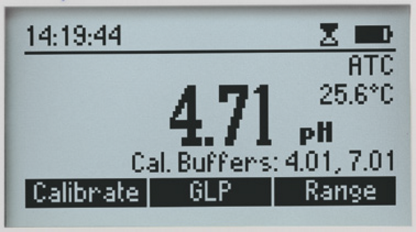 pH Measurement Mode
pH Measurement ModeSelecting the pH measurement mode allows for the photometer to be used as a professional pH meter with many features including temperature compensated measurements, automatic two point calibration, and GLP.
Advanced Optical System
HI83325 is designed with an innovative optical system that incorporates a beam splitter so that light can be used for absorbance readings and for a reference detector. The reference detector monitors the intensity of light and modulates when there is drift due to power fluctuation or the heating of the optical components. Each part has an important role in providing unparalleled performance from a photometer.

High Efficiency LED Light Source
An LED light source offers superior performance as compared to a tungsten lamp. LEDs have a much higher luminous efficiency, providing more light while using less power. They also produce very little heat, which could otherwise affect the optical components and electronic stability. LEDs are available in a wide array of wavelengths, whereas tungsten lamps are supposed to be white light (all wavelengths of visible light) but actually have a poor blue/violet light output.
High-Quality Narrow Band Interference Filters
The narrow band interference filter not only ensures greater wavelength accuracy (+/- 1 nm) but are extremely efficient. The filters used allow up to 95% of the light from the LED to be transmitted as compared to other filters that are only 75% efficient. The higher efficiency allows for a brighter, stronger light source. The end result is higher measurement stability and less wavelength error.
Reference Detector for a Stable Light Source
A beam splitter is used as part of the internal reference system of the HI83325 photometer. The reference detector compensates for any drift due to power fluctuations or ambient temperature changes. Now you can rely on a stable source of light between your blank (zero) measurement and sample measurement.
Large Cuvette Size
The sample cell of the HI83325 fits a round, glass cuvette with a 25 mm path length. Along with the advanced optical components, the larger size of the cuvette greatly reduces errors in rotation from the indexing mark of the cuvettes. The relatively long path length of the sample cuvette allows the light to pass through more of the sample solution, ensuring accurate measurements even in low absorbance samples.
Focusing Lens for Greater Light Yield
Adding a focusing lens to the optical path allows for the collection of all of the light that exits the cuvette and focusing the light on the silicon photodetector. This novel approach to photometric measurements cancels the errors from imperfections and scratches present in the glass cuvette eliminating the need to index the cuvette.
| SKU | HI83325-02 |
|---|---|
| Product Name | Nutrient Analysis Photometer – HI83325 |
| Quote Required | Yes |
| pH Measurement Type | potentiometric pH electrode |
| pH Range | -2.00 to 16.00 pH |
| pH Resolution | 0.01 pH |
| pH Accuracy | ±0.01 pH |
| pH Calibration | Automatic one or two point calibration with one set of standard buffers available (4.01, 6.86, 7.01, 9.18, 10.01) |
| pH Temperature Compensation | Automatic (-5.0 to 100.0 oC; 23.0 to 212.0 oF); limits reduced based on the pH electrode used |
| pH CAL Check (electrode diagnostics) | clean electrode and check buffer/check probe displayed during calibration |
| pH-mV Range | ±1000 mV |
| pH-mV Resolution | 0.1 mV |
| pH-mV Accuracy | ±0.2 mV |
| Absorbance Range | 0.000 to 4.000 Abs |
| Absorbance Resolution | 0.001 Abs |
| Absorbance Accuracy | +/-0.003Abs @ 1.000 Abs |
| Ammonia Range | Low Range |
| Ammonia Resolution | 0.01 mg/L; 0.1 mg/L |
| Ammonia Accuracy | Low Range |
| Ammonia Method | Adaptation of the ASTM Manual of Water and Environmental Technology, D1426-92, Nessler method |
| Calcium Range | Freshwater |
| Calcium Resolution | 1 mg/L |
| Calcium Accuracy | Freshwater |
| Calcium Method | Freshwater |
| Magnesium Range | 0 to 150 mg/L (as Mg2+) |
| Magnesium Resolution | 1 mg/L |
| Magnesium Accuracy | ±5 mg/L ±3% of reading |
| Magnesium Method | Adaptation of the Calmagite method |
| Nitrate Range | 0.0 to 30.0 mg/L (as NO3–– N) |
| Nitrate Resolution | 0.1 mg/L |
| Nitrate Accuracy | ±0.5 mg/L ±10% of reading |
| Nitrate Method | Adaptation of the cadmium reduction method |
| Phosphate Range | Freshwater High range |
| Phosphate Resolution | 0.1 mg/L |
| Phosphate Accuracy | ±1 mg/L ±4% of reading |
| Phosphate Method | Adaptation of the Standard Methods for the Examination of Water and Wastewater, 18th edition, Amino Acid method |
| Potassium Range | 0.0 to 20.0 mg/L (as K) |
| Potassium Resolution | 0.1 mg/L |
| Potassium Accuracy | ±3.0 mg/L ±7% of reading |
| Potassium Method | Adaptation of the Turbidimetric Tetraphenylborate method |
| Sulfate Range | 0 to 150 mg/L (as SO42-) |
| Sulfate Resolution | 1 mg/L |
| Sulfate Accuracy | ±5 mg/L ±3% of reading |
| Sulfate Method | Turbidimetric – Sulfate is precipitated with barium chloride crystals |
| Input Channels | 1 pH electrode input and 3 photometer wavelengths |
| pH Electrode | digital pH electrode (not included) |
| Photometer/Colorimeter Light Source | 3 LEDs with 420 nm, 466 nm, and 525 nm narrow band interference filters |
| Photometer/Colorimeter Light Detector | silicon photodetector |
| Bandpass Filter Bandwidth | 8 nm |
| Bandpass Filter Wavelength Accuracy | ±1 nm |
| Cuvette Type | round, 24.6 mm |
| Number of Methods | 128 max. |
| GLP | calibration data for connected pH electrode |
| Display | 128 x 64 pixel LCD with backlight |
| Logging Type | log on demand with user name and sample ID optional input |
| Logging Memory | 1000 readings |
| Connectivity | USB-A host for flash drive; micro-USB-B for power and computer connectivity |
| Power Supply | 5 VDC USB 2.0 power adapter with USB-A to micro-USB-B cable (included) |
| Battery Type/Life | 3.7 VDC Li-polymer rechargeable battery / >500 photometric measurements or 50 hours of continuous pH measurement |
| Environment | 0 to 50.0 oC (32 to 122.0 oF); 0 to 95% RH, non-condensing |
| Weight | 1.0 kg (2.2 lbs.) |
| Dimensions | 206 x 177 x 97 mm (8.1 x 7.0 x 3.8″) |
| Ordering Information | HI83225 is supplied with sample cuvettes and caps (4 ea.), cloth for wiping cuvettes, USB to micro USB cable connector, power adapter and instruction manual. |

